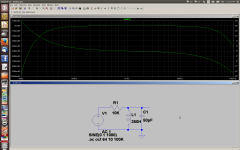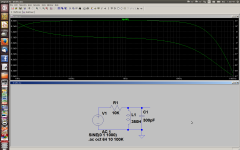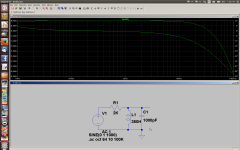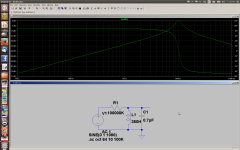Note this assumes an ideal inductor with 1K DCR, in practice there will be appreciable shunt capacitance across the inductor.
I've added a second one where I added additional shunt capacitance which includes miller capacitance and the shunt capacitance of the choke.
The third one shows a better implementation with a lower rp tube, and likely a realistic amount of shunt capacitance.
I've added a second one where I added additional shunt capacitance which includes miller capacitance and the shunt capacitance of the choke.
The third one shows a better implementation with a lower rp tube, and likely a realistic amount of shunt capacitance.
Attachments
No, my dear Kevin. Resistance affects Q, not to resonant frequency.
f = 1/(2 pi sqrt (L * C))
Z = sqrt (L/C)
Q = (2 Pi L) / R
f = 1/(2 pi sqrt (L * C))
Z = sqrt (L/C)
Q = (2 Pi L) / R
See above, and I have measured exactly this behavior in the past. For the above to be true the source impedance of the driving source must be infinite. No question there can be problems with the implementation as my graphs show. (The source impedance appears in parallel with the inductive reactance and at all but very low frequencies completely swamps it.)
This is a common approach with tubes like the 50, AD1, and others where grid circuit dc resistance must be kept to 10K or less. I prefer ITs in most instances, but good ones are very expensive. Power drive would be a modern and suitable alternative.
This is a common approach with tubes like the 50, AD1, and others where grid circuit dc resistance must be kept to 10K or less. I prefer ITs in most instances, but good ones are very expensive. Power drive would be a modern and suitable alternative.
Here is the case that most closely illustrates your concern, to do so I had to remove the effects of DCR in the choke and drive it from a 100Mohm source, but it shows a clear 10kHz resonance, but the conditions modeled do not even remotely reflect actual usage.
Attachments
OK, but I still keep lots of questions about the use of such an inductor in such a circuit.
Resonance may or may not be of importance, but always is present. Also, an inductor has stronger nonlinearities than a humble high value resistor (say 220K), and it is also capable of high distortion, hum inducing and may be noisier than the resistor. And nothing to say about it's weight, bulk, size and higher cost device. Also a word with regard to their incontrolable parasitics.
Resonance may or may not be of importance, but always is present. Also, an inductor has stronger nonlinearities than a humble high value resistor (say 220K), and it is also capable of high distortion, hum inducing and may be noisier than the resistor. And nothing to say about it's weight, bulk, size and higher cost device. Also a word with regard to their incontrolable parasitics.
All true of course, but there are situations where this works better than many other alternatives; specific cases where the dc resistance in the grid circuit has to be low, and the builder does not want sand in the signal path. (source follower typically)
I had a set of very nice Sowter 4000H grid chokes given to me which I will use someday. Driven by a low impedance driver based around the 5842, C3G or D3A for example HF extension should be very reasonable.
I had a set of very nice Sowter 4000H grid chokes given to me which I will use someday. Driven by a low impedance driver based around the 5842, C3G or D3A for example HF extension should be very reasonable.
Reason why i doubt resonances, is triode with low resistance will take care of any resonances.
And if you use pentodes to drive chokes, its your problem
And if you use pentodes to drive chokes, its your problem
I am happy to report that the AD1 amp that started this thread is finished! When I was asked to build this amp I looked at the Emissions Labs website. The site stated that any circuit using 2A3 outputs would work providing it could accommodate the 4 volt filament voltage. What I didn't know was that there were no schematics using push pull and fixed bias. (At least not that I could find.) And I only found one or two that used AD1 and those were SE and cathode bias. The tubes run almost -80 volts to bias the grids.
The weird distortion I had is gone. The amp is very quiet and sounds nice. At only 15 watts it's not a powerhouse and I only have one so stereo is out. The owner is a 78 fan and he says the only way to listen to 78's is in mono with one speaker.
I want to thank Kevin for all his help over the last two years. And also Rod Coleman for his help with the filament regulators.
The weird distortion I had is gone. The amp is very quiet and sounds nice. At only 15 watts it's not a powerhouse and I only have one so stereo is out. The owner is a 78 fan and he says the only way to listen to 78's is in mono with one speaker.
I want to thank Kevin for all his help over the last two years. And also Rod Coleman for his help with the filament regulators.
It was my pleasure to help, and delighted to hear that things turned out well in the end. Sometimes the hard slog is the best learning opportunity. 😀
- Status
- Not open for further replies.
- Home
- Amplifiers
- Tubes / Valves
- Grid Chokes



